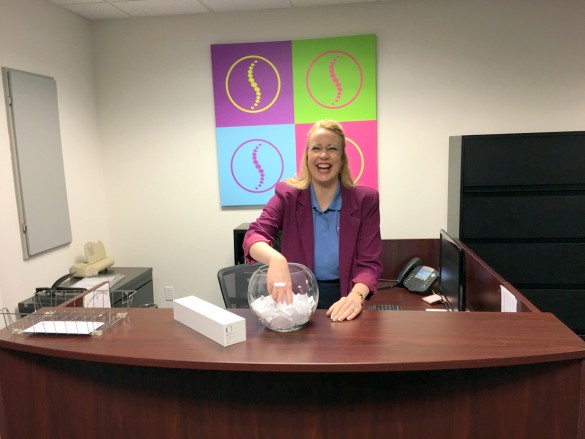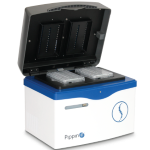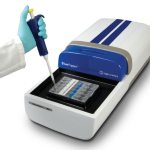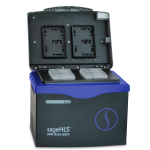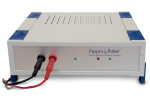ChIA-PET Study Demonstrates Effect of Genome Folding on Gene Expression
For a recent publication in Cell, scientists used the SageELF whole-sample fractionation platform to perform size selection prior to cDNA sequencing on the PacBio system. The Iso-Seq method allows PacBio users to generate full-length transcripts, and SageELF makes it easier to pool size fractions and include the exact size range of interest for the study.
In this paper, “CTCF-Mediated Human 3D Genome Architecture Reveals Chromatin Topology for Transcription,” the PacBio data set complemented short-read sequence data. Lead authors Zhonghui Tang, Oscar Junhong Luo, and Xingwang Li, along with senior author Yijun Ruan, worked with collaborators at the Jackson Lab and several other institutes to better understand genome organization and its implications for transcription.
The scientists used ChIA-PET (a much-needed abbreviation for “chromatin interaction analysis by paired-end tag sequencing”) to perform 3D mapping of the genome in four types of human cells, focusing on interactions mediated by transcription catalyst RNAPII and CTCF, which is known to play a role in genome folding. Separately, they studied gene expression with long-read sequencing.
“We find that CTCF/cohesin-mediated interaction anchors serve as structural foci for spatial organization of constitutive genes concordant with CTCF-motif orientation,” the authors report, “whereas RNAPII interacts within these structures by selectively drawing cell-type-specific genes toward CTCF foci for coordinated transcription.” They also show that changes in haplotype or allele interactions affect chromosomal configuration and alter gene expression.
This PAG Was One for the Birds (and Other Organisms, Too)
The 24th annual PAG meeting ended earlier this week, and we thoroughly enjoyed ourselves — as did just about every other attendee we encountered. The avian genomics community one-upped everyone else by going on bird-watching excursions and tweeting photos of their finds along with challenges to identify each species. (The Sage team was stumped!) Erich Jarvis’s great plenary talk on the neural circuits involved in vocal learning also put our feathered friends in the spotlight and had scientists atwitter with new research ideas.
We really enjoyed the Hi-C talk from Erez Lieberman Aiden from Baylor College of Medicine. He walked attendees through his hypothesis that DNA loops form by extrusion rather than diffusion, stopping at the CTCF motif in a certain direction. The analysis of 3D formation and folding of DNA has inspired scientists around the world to use this technique to better understand how proximity in space, rather than in linear sequence, affects gene expression.
The Sage team attended several excellent talks, but lots of attendee interest kept us at our booth most of the time. We loved hearing about the incredibly creative research going in on so many model organism communities, and it was terrific to see how many projects could benefit from automated DNA size selection. (If you didn’t get a chance to talk to a Sage member at PAG, please check out our SageELF and BluePippin pages to learn more about two of the instruments we offer for NGS users.)
Also, don’t forget that there’s still time to enter the new SMRT Grant program we’re co-sponsoring with PacBio. Tell us what makes your favorite organism’s genome so interesting, and the lucky winner will get a genome sequence on the house.
On Our Way to the 24th Annual PAG Conference
We’re heading to San Diego this weekend, braving historic rain and mudslides for our favorite agbio conference: the International Plant & Animal Genome meeting, held January 9-13. Each year, thousands of scientists descend on the Town and Country hotel to share the latest research developments about model organisms, important crops, and more.
This year’s program is as strong as ever, with plenary talks coming from John Quackenbush, Erich Jarvis (we loved his presentation on Disco the parakeet at last year’s AGBT meeting), Jan Leach, and others. Concurrent sessions tend to be organism-centric, giving researchers a nice chance to catch up with their colleagues from other institutions.
The Sage Science team will once again be exhibiting at PAG — please stop by booth 422 to say hello. Our automated DNA size selection tools have proven quite useful for generating higher-quality genome assemblies and for analyzing gene expression, and we look forward to the opportunity to see whether they could be helpful for your research projects.
We’ll also be co-sponsoring the SMRT Grant program with Pacific Biosciences to award one lucky winner a genome sequence of an organism of interest (up to 10 SMRT Cells, with BluePippin size selection). Click here to learn more.
We hope to see you in San Diego!
2015: A Look Back
People are starting to talk about their plans for New Year’s Eve, confirming a suspicion we’ve had for a while now: 2015 really is winding down! We can’t believe that 2016 is nearly upon us. As we try to remember the blur of the last 12 months, we’re taking stock of the highlights and trends that transpired. Here on the home front, the big news was how well our newest instrument, PippinHT, has done. Our customers have run tens of thousands of samples with PippinHT so far, and they show no signs of easing up.
Early this year, we put forth our theory that 2015 would be remembered as the year of long reads. With the momentum of Oxford Nanopore technology and the much-anticipated release of PacBio’s new Sequel System, it seems clear that long-read sequencing is no longer a niche approach. Numerous studies have shown that long-range DNA information is essential to building more accurate and complete genome assemblies, providing insight that isn’t available from other sequencing methods. Even researchers who haven’t switched to long-read sequencers are trying to incorporate long-range data into their studies; we’ve seen a lot more interest in mate-pair sequencing, as well as synthetic long-read technologies.
In 2015 we sponsored our first-ever podcasts with Mendelspod, and they’ve been a huge success. If you missed any of these great interviews with Bobby Sebra, Chris Mason, or Rod Wing, you should definitely spend your next commute tuning in. Mendelspod host Theral Timpson always does a good job of getting his interviewees to provide really interesting perspectives on trends in the industry.
As usual, the Sage Science team spent a good deal of time on the conference circuit this year. We loved getting to interact with friends, collaborators, and customers, and look forward to doing more of the same next year. You can catch our coverage of some of the big meetings here: ABRF, AGBT, ASHG, ASM, Festival of Genomics, and PAG. We also recapped our experience at the PacBio user group meetings here and here.
One of our favorite developments of the year was the publication of some great new protocols involving Pippin automated DNA size selection instruments from our customers. We particularly liked new mate-pair sequencing protocols (here and here), and this video protocol for methylation mapping.
Of course, Sage customers publish a lot more than protocols. There were too many terrific papers to list here, but if you have time for only a few, here’s what we recommend:
– A better approach to microRNA biomarker discovery
– A diploid human genome assembly
– Targeted capture and sequencing of human structural variation
We even got to spend some time profiling a few of our customers this year. Many thanks again to our customers for taking the time, and we hope you enjoy these glimpses of their impressive work:
– Amanda Chilaka, Whitehead Institute
– Darren Heavens, The Genome Analysis Centre
– Alex Maslov, Albert Einstein College of Medicine
And that’s a wrap for 2015! From everyone at Sage, we wish you a wonderful holiday season, and a happy and healthy new year.
Sage Survey Results: Who Won the Apple Watch?
A few weeks ago we asked people to participate in a quick survey to help us make sure that our product development efforts are focused on areas of greatest need to the community. We were blown away by the response — many thanks to all of you who took time out of your busy days to offer your perspective.
We wanted to share a little bit about what we heard. Most respondents work in research, though a fair number came from the clinical realm. The most common genomics applications they use are RNA-seq, targeted sequencing, genome resequencing, and de novo genome sequencing. The single biggest sample prep challenge they reported was dealing with low-input or precious samples. While the vast majority of respondents use short-read sequencers, they expressed a lot of interest in adding long-read sequencing or synthetic long-read data to their pipelines.
We also offered participants the chance to win an Apple Watch. We printed out the list of respondents who asked to enter the drawing, and then we chose Tanja, the cheeriest member of the Sage team, to select our winner (as you can see, she had a good time!). Congratulations to Davinder Sandhu at Weill Cornell Medical College for winning the watch!
